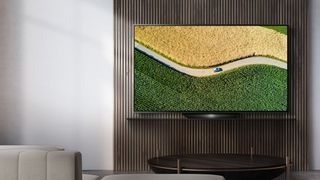
TVs are surrounded by terms that sound like jargon. But OLED is one word you need to get to grips with when buying a new TV.
LG’s OLED TVs are some of the best in the world. And part of that excellence comes from the way the technology works.
OLED TVs have emissive pixels. Each is its own light source, so when you dim the lights for a movie night, the areas of black in a Star Wars or Gravity space scene look absolutely, completely dark. Spend as much as you like, you can’t get this with any LCD TV or projector, even those used in your local cinema.
This is OLED’s super power. There are many other benefits too.
LG’s OLED TVs have a response rate of up to 0.01 millisecond, up to 1000 times faster than an LCD. This tells you how quickly the display can shift from one colour or tone to another. OLED’s amazing speed rules out the chance of any response-related smearing or motion blur. It makes fast action scenes much clearer, and punchier-looking.
A universe of colours
There’s more to TV colour than you might expect too.
One half of the LG OLED colour performance is simple: the more colours a TV can display, the better. LG’s OLED TVs can handle a billion of them, from the deepest reds to the bright subtle haze of a morning city skyline.
You also need pro-grade colour calibration to get accurate colour rather than just vivid colour. And every LG OLED TV has incredible colour tuning.
You’ll often notice this most in the tones of a character’s face, or the grass of a football pitch. A too-red skin tone or foliage that looks fluorescent are giveaways a TV can’t handle colour as well as an LG OLED.
The last World Cup was a good test for a TV. Remember Messi’s bright green boots? An LG OLED TV can bring out the day-glo lime green of them while keeping the surrounding grass look worthy of a nature documentary. You want punchy colour, but with the fidelity to make sure scenes look realistic.
There are other real practical benefits to an LG OLED TV. Viewing angles matter if, like most, you have a living room setup where most people don’t get to see the TV dead-on.
LG’s OLED TVs offer a 178-degree viewing angle. The screen won’t seem dim, of its colours off, if you’re the one who gets the worst seat in the house.
Dolby Atmos: Sound advice
The highlights aren’t restricted to image quality either. Sound is a highlight too. LG’s OLED TVs have Dolby Atmos, the same technology built into the newly refurbished Odeon Luxe cinema in London’s Leicester Square. It lets you perceive the position of objects in movie soundtracks in 3D.
We’re not talking about simple stereo anymore, or even standard surround. You can tell the height of a helicopter in the sound field, and cars tearing past will seem to extend far further than they would through a simple stereo mix. It’s “object based” audio, where the boffins who mix a movie’s audio track can position sound in a 3D space.
Dolby Atmos uses psychoacoustic processing to achieve this without making you splatter your living room ceiling with speakers. Psychoacoustics is the study of how we perceive sound: LG OLED TVs more-or-less have a PhD in the subject.
Atmos isn’t just for film anymore, either. Sky and BT now broadcast important sporting events in Dolby Atmos. It is like being there, but without the drizzle and overpriced snacks.
LG OLED TVs shine when you feed them the best content on offer today. 4K video looks incredible on these displays. But they are prepped for the low-quality stuff too.
LG’s AI Picture technology analyses whatever you watch, from a programme broadcast on BBC One HD to an old DVD you’ve wanted to re-watch for ages. It brings out more image information in the shadow areas, and makes the picture sharper, clearer and more lifelike.
As much as we’d like everything we watch to be in 4K, with an amazing Atmos soundtrack, a truly great TV needs to be prepped for the content equivalent of comfort food that we all like to unwind to after a day at work.
You’ll find all of these innovations in LG’s 2019’s OLED TVs, from the C9 and E9 families. Prices start from £2499 at ao.com
Get daily insight, inspiration and deals in your inbox
Get the hottest deals available in your inbox plus news, reviews, opinion, analysis and more from the TechRadar team.
